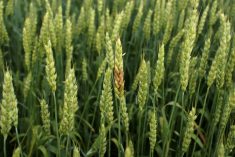Field trial results for new malting barley varieties could encourage Manitoba farmers to give the crop a second look. That’s the hope of Peter Watts, managing director of the Canadian Malting Barley Technical Centre.
“The basic message is that new malting barley varieties can be grown successfully in Manitoba, meet the quality criteria of end users, and also perform well for farmers in terms of agronomic factors like yields and disease resistance,” said Watts.
Why it matters: Buyers have been slow to adopt new malt barley genetics, to the frustration of growers who would love to capitalize on better disease packages or yield.
Read Also

Still hard to predict precise fertilizer payback
Despite decades of advances, international research finds no clear answer for where and when adding nutrient will fail to boost growth.
The field tests compared the malting barley varieties AAC Connect, CDC Fraser, CDC Copper, AAC Goldman, CDC Bow, CDC Churchill and AAC Prairie against AAC Synergy as the check.
AAC Synergy is the No. 1 barley variety in Western Canada, representing 32 per cent of all barley seeded in the region this year.
For a long time it was considered a relative newcomer on the barley scene, despite being registered for years. Its major competitors, standbys like CDC Copeland and AC Metcalfe, were available before the turn of the millennium. AAC Synergy was a game changer when it was registered in 2012.
“It was head and shoulders above the existing varieties in terms of yields,” Watts said. “So, it was really exciting because, all of a sudden, it really helped keep barley as a viable, competitive option for producers.”

As of 2019, the technical centre reported that 44 per cent of the malt barley in Western Canada was planted to CDC Copeland, 23.7 per cent to AC Metcalfe and 19.2 per cent to AAC Synergy. By last year, AAC Synergy had crept within a few percentage points of CDC Copeland, while AC Metcalfe slid to 9.2 per cent, behind AAC Connect.
In a sea change for the sector, AC Metcalfe did not make the centre’s list of recommended varieties for 2023-24. CDC Copeland was still there with stable demand but declining production, and AAC Synergy’s demand was also starting to slip. AAC Connect and CDC Fraser were on an upward trend.
“These new varieties are yielding comparably to Synergy, which is very impressive,” said Watts.
As well, all the new varieties have incremental improvements in disease resistance and lodging resistance, traits that are important to end users, he added.
More acres
Watts hopes the results will get more barley into Manitoba farm rotations.
“We all know that there’s been pretty heavy reliance on crops like canola and wheat, and perhaps rotations haven’t been as diverse as maybe they should be in order to keep the soils healthy,” he said.
The newer varieties show yields as much as 25 per cent better than varieties from a quarter century ago and with better disease packages.
Producers might also want to consider the local marketing opportunities for the crop, Watts said.
“If you grow malt barley, you can always sell it as feed. These new varieties have comparable yields to the feed varieties. You may as well just grow a malt variety … then you’ve got two markets to sell it.”
The newer varieties also perform well on the main criteria malting companies look for when selecting barley, like protein levels, germination rates and being disease-free.
Manitoba barley through the years
According to Manitoba Agriculture cereals specialist Anne Kirk, roughly 414,000 acres of barley were planted in Manitoba this year, and the five-year average is 382,000. Barley acres bottomed out in 2017 but climbed steadily until 2020 and have remained stable since then.
Those numbers pale compared to what they used to be.
“There was a time in Manitoba when we were producing well over a million tonnes of barley a year – closer to two million back in the ‘80s,” said Watts.
Then the ‘90s hit.
“1993 was sort of this watershed year, when there was just this terrible fusarium head blight infection across Manitoba. It really pushed producers away from going barley,” said Watts.
Other factors contributed to the grain’s decline, including the suitability of Red River Valley soils for growing soybeans.
Saskatchewan and Alberta barley crops didn’t face those headwinds. Their soils are less suitable for soybeans, and drier climates shielded them from the worst of the fusarium outbreaks.
Today, Saskatchewan and Alberta remain the big producers of barley, while Watts estimates Manitoba is down to 500,000 to 600,000 tonnes a year.
That western Prairie prevalence is one reason Watts says the Manitoba trials are so important.
Local data
Tests surrounding the newer varieties’ registrations tend to be done where most barley is grown, in Saskatchewan and Alberta. This new data is tailored to Manitoba.
“If you’re farming in the Wawanesa area, for example, and someone not too far away from you has been doing a trial, at least you can look at what they’ve been seeing in terms of yield and quality to see if you may be interested in trying a variety,” said Kirk.
“So, it’s beneficial for farmers that may be interested in growing malting barley or looking at switching varieties.”
She cautioned that barley doesn’t work in everyone’s production system.
“We see more malting barley in specific areas of the province where those farmers are more likely to achieve malting quality,” she said. “There are some farmers that would never consider growing malting barley because they just maybe haven’t had good success with it in the past, or it’s just not a common practice in their area based on their environmental conditions.”
Market acceptance is also critically important to consider when choosing a variety, Kirk noted. A number of malting varieties might have all the right properties, but they aren’t on the malting acceptance recommended list.
“That may just be because the malt houses are happy with the variety they have or the way a certain variety performs,” she said.
“So, when farmers are choosing varieties, they should be looking at the CMBTC’s recommended variety list so they know that there is demand for those varieties.”
















